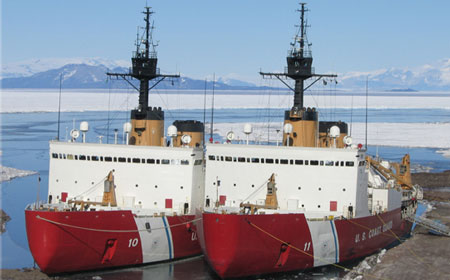
The U.S Coast Guard presently operates just two icebreakers: the heavy icebreaker
Polar Star, which is tasked with Antarctic breakout and resupply operations,
and the medium icebreaker Healy, which carries out Arctic scientific research
for the National Science Foundation.
In 2006, a law designated the Polar-class primarily as research vessels.
Because of that, the National Science Foundation paid for and ran the United States’
icebreaking vessels, using the Coast Guard crews. In 2009, the NSF announced
that they would end funding for maintain Polar Star.
In March 2010, U.S. Coast Guard Admiral Thad Allen announce that Polar Star
would receive a $62 million overhaul. Seattle’s Vigor Industrial shipyard
completed the overhaul in four years and Polar Star was assigned back to
operations in early 2014. In the last few years, members of her crew sometimes
refer to the ship as a “rust bucket,” signaling the need for further overhaul
or replacement.
On February 22, 2017, the U.S. Coast Guard announced it had awarded five fixed-price
contracts worth $20 million for the future heavy polar icebreaker design studies and
analysis. In 2018, Commandant Admiral Zukunft said the icebreakers would be
designed with space, weight, and power reservations sufficient to weaponize icebreakers
at some point in the future. It was also announced that the icebreakers would
be called Polar Security Cutters.
On April 23, 2019, the Coast Guard and the Navy awarded VT Halter Marine a $745
million detailed design and construction contract for the lead Polar Security Cutter.
The icebreaker will be constructed at the company’s Pascagoula, Mississippi
shipyard. The contract with Halter Marine also included options to build two
more Polar Security Cutters. If both options are exercised, the contract value
increases to $1.9 billion for the three icebreakers.
The Polar Security Cutter (PSC) program will replace the current icebreakers
with three heavy and three medium icebreakers. The first of the three heavy
icebreakers is expected to deliver in 2023. Seattle, Washington will remain
the home of the icebreaker fleet.
Each winter the Coast Guard currently sends icebreakers as south as possible
to lead supply ships into McMurdo Sound, Antarctica, to resupply the National Science
Foundation’s research center. Each summer, the Coast Guard send icebreakers
to perform similar missions to assist shipping off the Alaskan coast. The organization
also maintains a U.S. presence in the Arctic, defending national interests in the
region, which is increasingly becoming a focus for Russia and China.
